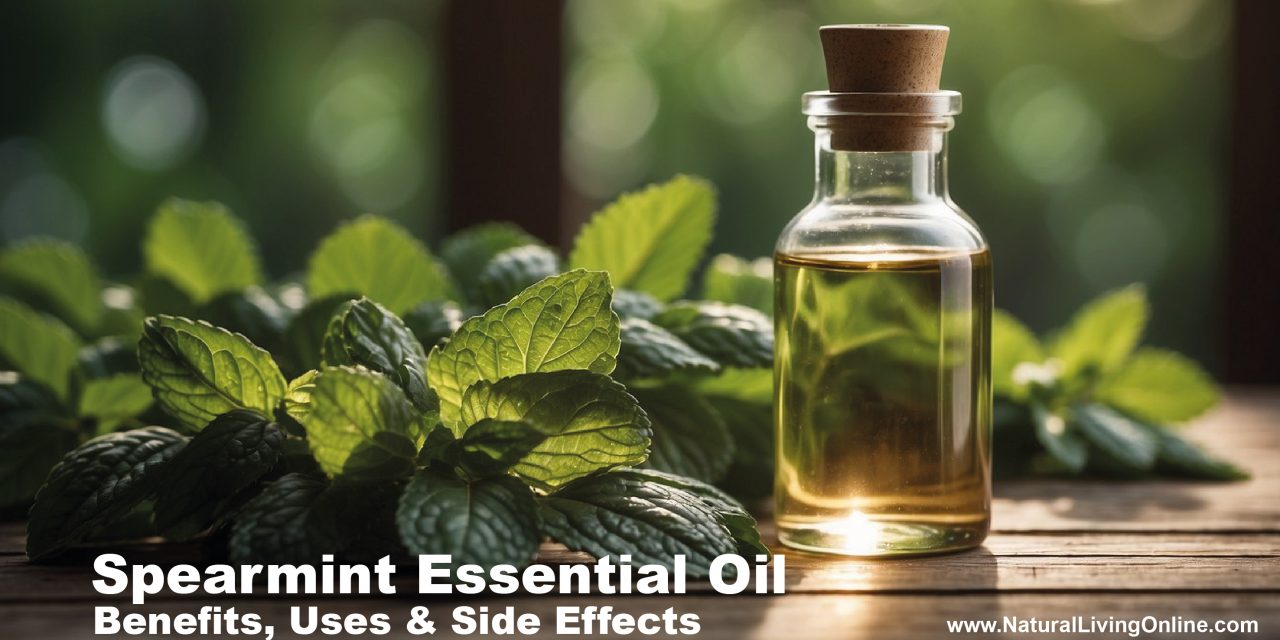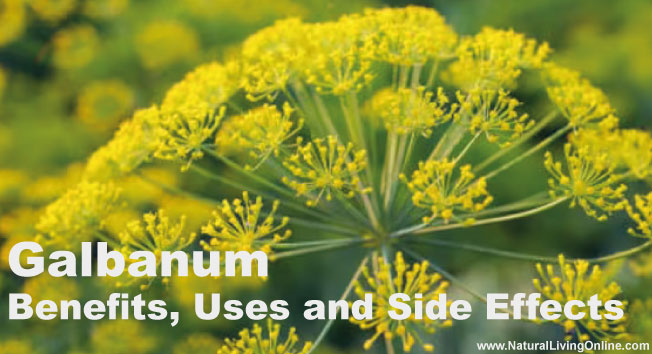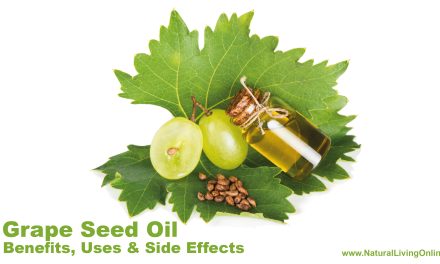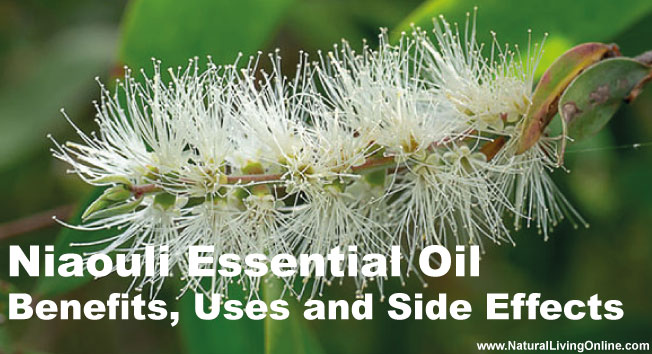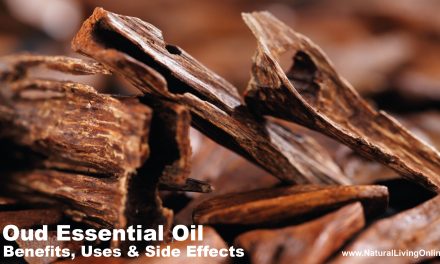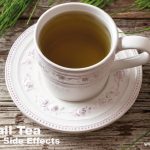Spearmint essential oil, a derivative of the Mentha spicata plant, is esteemed for its versatile uses and benefits. This essential oil is recognized for its distinctive aroma, making it a popular choice within the realms of aromatherapy and personal care. Its active compounds include menthol, carvone, and limonene, which underpin its reputation for promoting digestive health, soothing discomfort, and invigorating the senses.
While it is celebrated for its therapeutic properties and widespread utility in culinary and cosmetic applications, it is also important to consider the potential side effects. Users of spearmint essential oil should be aware of correct usage to avoid skin irritation or adverse reactions associated with improper dilution or application. With a balanced approach to usage and safety, spearmint essential oil remains a valuable natural remedy and additive.

Key Takeaways
- Spearmint essential oil is lauded for its multitude of therapeutic, culinary, and cosmetic applications.
- Proper usage and awareness of potential side effects are important for safe and effective application.
- The oil contains active compounds such as menthol and carvone, which contribute to its health benefits.
Origins and Composition
Spearmint, scientifically known as Mentha spicata, is a species of mint that has a wide range of applications due to its aromatic properties and its composition of beneficial compounds.
Spearmint Vs Peppermint
Spearmint, commonly referred to as garden mint, is often confused with peppermint. While both are part of the Mentha genus, spearmint contains a lower amount of menthol, typically less than 1%. This contrasts with peppermint, which can contain up to 40% menthol. Spearmint’s milder menthol content results in a softer flavor and fragrance, which makes it distinct from the more intense and cooling sensation of peppermint.

Essential Oil Profile
Botanical Name: Mentha spicata
Common Names: Spearmint
Plant Family: Lamiaceae (mint family)
Countries of Origin: Spearmint is native to the Mediterranean region, but it is also cultivated in other parts of Europe, Asia, and North America.
Extraction Method: Spearmint essential oil is typically extracted through steam distillation of the flowering tops of the spearmint plant.
Parts Used: Flowering Tops
Essential Oil Smell: Spearmint essential oil has a fresh, sweet, and minty aroma with herbaceous and slightly fruity undertones. It is often described as uplifting, invigorating, and cooling.
Essential Oil Color: Clear to pale yellow.
Viscosity: Thin
Perfumery Note: Top Note
Strength of Aroma: Medium
Blends Well With:
- Citrus oils like lemon and lime
- Herbal oils such as lavender and rosemary
- Woody oils like cedarwood and pine
- Spice oils like peppermint and ginger
Therapeutic Properties:
- Digestive
- Antispasmodic
- Stimulant
- Analgesic
- Antimicrobial
- Respiratory
Uses:
- Digestive Health: Spearmint oil is used to alleviate digestive issues such as indigestion, bloating, and nausea. It can help relax the digestive tract, relieve gas and cramps, and promote healthy digestion when diluted and applied topically or diffused.
- Respiratory Support: Spearmint oil is believed to have decongestant and expectorant properties that can help clear respiratory congestion, relieve coughs, and support respiratory health. It can be diffused or added to steam inhalations.
- Oral Care: Spearmint oil is commonly used in oral care products such as toothpaste and mouthwash for its refreshing flavor and antimicrobial properties. It can help freshen breath, reduce oral bacteria, and promote healthy gums.
- Mental Clarity: Spearmint oil is used in aromatherapy to promote mental clarity, improve focus, and uplift mood. It is often diffused or used in massage blends to reduce mental fatigue and enhance cognitive function.
Contraindications:
- Spearmint oil is generally safe for topical and aromatic use. However, it should be used in moderation and diluted properly before applying it to the skin, as it may cause skin irritation in some individuals.
- Pregnant women should avoid using spearmint oil in large amounts, as it may stimulate uterine contractions.
Side Effects:
- In rare cases, spearmint oil may cause skin irritation or allergic reactions. Perform a patch test before using it topically and discontinue use if any adverse reactions occur.
- Avoid ingesting spearmint oil in large amounts as it may cause gastrointestinal upset.
Types:
- There are no specific types of spearmint oil, but different varieties of spearmint plants may produce essential oils with slightly different aromatic profiles and chemical compositions.
Chemical Constituents with Percentages
- The chemical composition of spearmint essential oil can vary depending on factors such as the variety of spearmint and the extraction method used. Some of its main constituents include:
- Carvone (50-70%)
- Limonene (5-15%)
- 1,8-cineole (5-10%)
- Menthol (1-5%)
- Linalool (1-5%)
The percentages may vary depending on factors such as the age of the plant, the part of the plant used, and the environmental conditions in which the plant grows.
Health Benefits and Therapeutic Uses

Spearmint essential oil is recognized for its various health benefits and therapeutic uses, ranging from alleviating digestive issues to its potential in pain management. It has also been appreciated for its role in respiratory health and mental wellness.
Digestive Health
Spearmint essential oil is often utilized for its ability to soothe digestive upsets. It can provide relief from nausea, indigestion, and bloating, which may make it a beneficial herbal remedy for those experiencing discomfort after eating. Spearmint tea, specifically, is a popular beverage that is linked with these digestive benefits.
Pain and Inflammation Management
The oil’s anti-inflammatory properties make it a natural choice for managing conditions related to inflammation, such as arthritis and osteoarthritis. It may also contribute to pain relief in sore joints and muscles, suggesting its usefulness in holistic pain management strategies.
Respiratory Benefits
For those with respiratory issues like asthma, spearmint essential oil can act as a decongestant. Its antimicrobial properties may help in reducing the presence of pathogens, potentially providing respiratory relief.
Mental Clarity and Stress Relief
Spearmint essential oil is credited with providing mental clarity and aiding in stress relief. The soothing aroma may contribute to relaxation and focus, while some research suggests that spearmint can help improve memory. This makes it a candidate for use in practices promoting mental health and cognitive function.
Culinary and Cosmetic Applications
Spearmint essential oil, recognized for its invigorating aroma, serves as a versatile substance with significant roles in both culinary and cosmetic domains, particularly prevalent in Europe and America.
Food Flavoring
In the culinary context, spearmint essential oil is a favored flavoring agent. Chefs and food manufacturers incorporate it into a myriad of dishes, often using it to impart a fresh, minty essence to desserts, confectionery like mints, and beverages such as tea. It’s also a traditional accompaniment for meat, where its cool, refreshing profile can balance and enhance savory flavors.
Skincare and Haircare
In terms of cosmetics, spearmint essential oil is cherished for its soothing and refreshing properties. It’s a common component in skincare products, contributing to formulations aimed at clarity and calmness. For haircare, its application spans from fortifying shampoos to nourishing conditioners, helping to maintain healthy scalp and lustrous locks. Furthermore, it’s integral in oral care products, such as toothpaste and mouthwash, due to its ability to freshen breath and offer antimicrobial benefits.
Precautions and Side Effects
When considering the use of spearmint essential oil, it is crucial to be aware of potential side effects and necessary precautions. While spearmint oil is known for its therapeutic properties such as alleviating symptoms of the common cold and digestive discomfort, it is not without its risks.
During Pregnancy and Lactation
Pregnant and lactating women should use spearmint essential oil with caution. Despite its potential to relieve pregnancy-related nausea, there is insufficient research to guarantee its safety during pregnancy and lactation. It is advised to consult a healthcare provider before use.
Interaction with Medications
Spearmint essential oil may interact with certain medications. It contains carvone, which can have physiological effects on the body. Patients should consult their healthcare professional before using spearmint essential oil, especially if they are on medication for the common cold, headaches, or any other condition.
Allergic Reactions and Sensitivities
Allergy to spearmint is possible, and individuals with a history of allergies to menthol or other related compounds should use spearmint essential oil cautiously. Allergic reactions can include:
- Headaches
- Skin rashes
- Respiratory complications
A patch test should be conducted before widespread use to ensure there is no sensitivity to the oil. Children may be particularly sensitive and require lower concentrations.
Spearmint in Scientific Research and Evidence
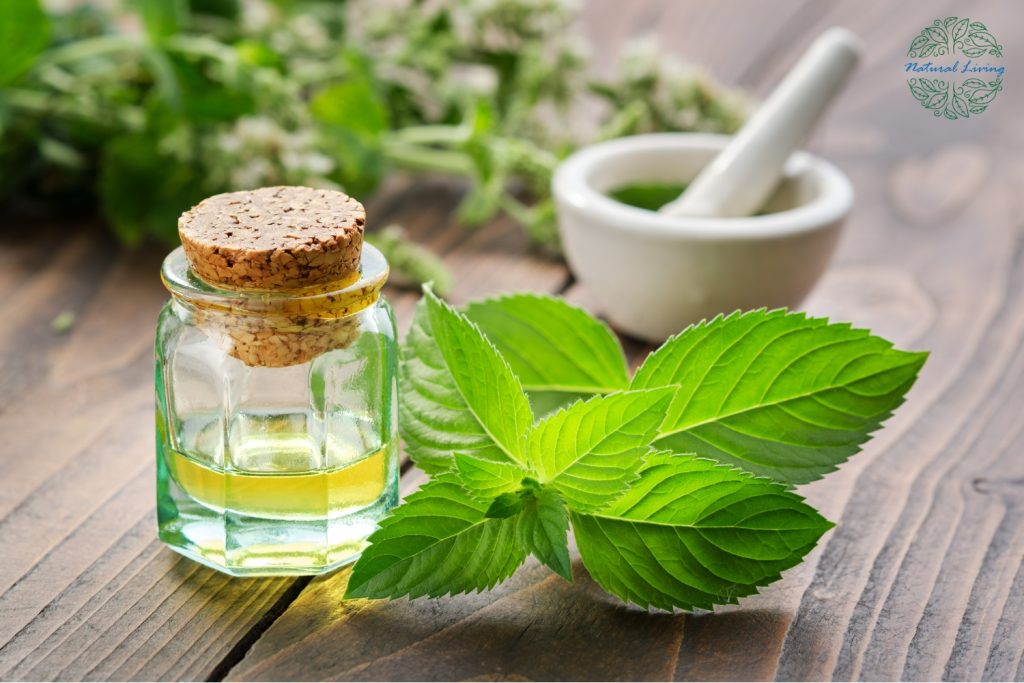
Recent scientific investigations have provided insights into the potential health benefits and mechanisms of action of spearmint. Researchers are particularly focused on its cognitive and hormonal effects, as well as its potential role in cancer treatment.
Cognitive Functions and Hormonal Balances
Studies on spearmint have demonstrated its potential in supporting cognitive functions. For instance, one of its active compounds, carvone, appears to offer antioxidant properties that could mitigate oxidative stress, a factor implicated in cognitive decline. An evidence-based review highlights spearmint’s ability to improve memory and alertness, suggesting possible benefits for those managing insomnia or anxiety.
In terms of hormonal effects, research suggests spearmint could play a role in addressing conditions like polycystic ovary syndrome (PCOS) and hirsutism. These conditions often involve hormone imbalances, and spearmint has been noted for its anti-androgenic effects, which could help in rebalancing hormones and alleviating symptoms like excess hair growth.
Cancer Research and Chemotherapy
In the realm of cancer research, spearmint has shown promise due to its various bioactive compounds. Preliminary studies suggest that these compounds might exhibit anti-cancer properties, potentially interfering with the growth and spread of cancer cells. As part of chemotherapy treatment, spearmint could support by mitigating some of the treatment’s adverse effects like nausea and vomiting, improving the overall quality of life for patients undergoing chemotherapy.
While the scientific evidence is encouraging, further research is needed to solidify the role of spearmint as a supportive agent in cancer care. The existing studies, however, provide a foundation for its potential use alongside standard treatments, with its ability to target bacteria, improve mood, and modulate blood pressure, reinforcing its profile as a beneficial herbal remedy in various contexts.
Usage Tips and Best Practices
When incorporating spearmint essential oil into your wellness routine, it’s crucial to focus on proper usage and selecting high-quality products to ensure effectiveness and safety.
How to Use Spearmint Essential Oil
Spearmint oil, known for its minty aroma and potential to soothe digestive upset such as flatulence and gas, can be used in various ways. For topical application, dilute the essential oil with a carrier oil such as coconut oil to prevent skin irritation. A common ratio is 3 drops of spearmint oil to 10 mL of carrier oil. It may also be inhaled directly or diffused to help alleviate symptoms of vomiting or to potentially sharpen learning processes. Due to its antioxidant properties, largely attributed to compounds such as rosmarinic acid, it can help combat free radicals. It’s important to start with a small amount and observe how your body reacts, especially if you are prone to allergic reactions.
Choosing Quality Spearmint Oil
Quality is paramount when it comes to selecting spearmint oil, as it directly affects the oil’s purity and potency. Look for oils that are certified organic and come from reputable sources within the Lamiaceae family. Quality oils typically offer comprehensive information, including the plant’s botanical name, Mentha spicata, and the method of extraction, which should be steam distillation. Confirming the presence of key constituents like carvone and checking for additives or synthetic fillers is also necessary for ensuring the oil’s efficacy. The product should be housed in dark glass bottles to protect it from light which can degrade the oil. Lastly, check for transparency in labeling, like mentioning the oil’s iron content, which can indicate a brand’s commitment to quality.
Frequently Asked Questions
What are the potential skin benefits of using spearmint essential oil?
Spearmint essential oil may provide antimicrobial properties that can be beneficial for skin health. It is also thought to have a soothing effect on the skin, which could help with conditions such as acne.
How can spearmint essential oil be used for optimal health benefits?
For optimal health, spearmint essential oil can be used in aromatherapy to promote relaxation and reduce stress. It can also be applied topically with a carrier oil for digestive or muscular discomfort.
Are there any known side effects of applying spearmint oil topically?
When applying spearmint oil topically, it is essential to dilute it with a carrier oil to avoid skin irritation. Those with sensitive skin may experience allergic reactions or topical dermatitis.
What internal effects can spearmint essential oil have on the body?
Internally, the use of spearmint essential oil might offer digestive benefits, such as alleviating symptoms of indigestion and stomach discomfort. However, approach internal use with caution and seek professional guidance.
In what ways does spearmint essential oil provide spiritual or emotional benefits?
Spearmint essential oil is believed to boost mental clarity and emotional wellbeing, potentially aiding in concentration and uplifting the spirit.
Can spearmint tea offer similar benefits to spearmint essential oil, and are there any risks?
Drinking spearmint tea could offer comparable digestive and anti-inflammatory benefits as the essential oil. However, excessive consumption may pose risks, particularly for individuals with kidney disorders.
References:
Effect of Spearmint Essential Oil On Chemical Composition and Sensory Properties of White Cheese
Instant effects of peppermint essential oil on the physiological parameters and exercise performance
This website does not provide medical advice.
All information provided on this website, and on associated social media networks, including but not limited to texts, images, and numbers are for general information purpose only. It is not intended as medical advice and it does not include all possible precautions, side effects, or interactions that may occur. Neither NaturalLivingOnline.com nor its author/founder take responsibility for how you use this information. Statements contained on NaturalLivingOnline.com have not been evaluated by the FDA. You should conduct thorough research via multiple sources and consult your physician or qualified doctor before using any essential oil or herbal remedy. Information on NaturalLivingOnline.com must not be relied upon for medical, legal, financial or other decisions.

